HONDA S2000 2000 1.G Owners Manual
Manufacturer: HONDA, Model Year: 2000, Model line: S2000, Model: HONDA S2000 2000 1.GPages: 273, PDF Size: 21.58 MB
Page 211 of 273
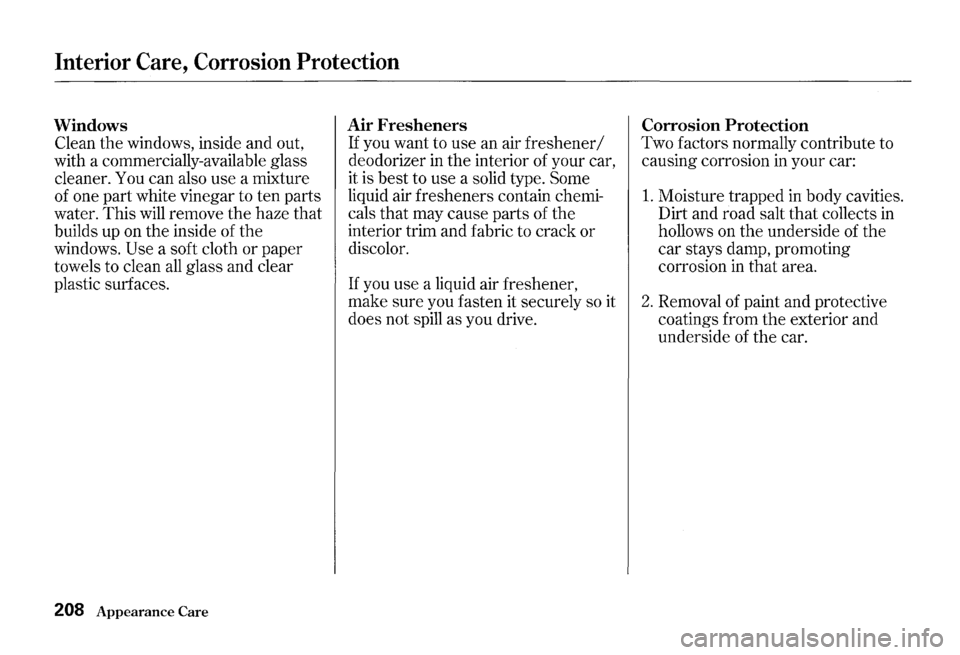
Interior Care, Corrosion Protection
Windows
Clean the windows, inside and out,
with a commercially-available glass
cleaner. You can also use a mixture
of one part white vinegar to ten parts
water.
This will remove the haze that
builds up on the inside of the
windows.
Use a soft cloth or paper
towels to clean all glass and clear
plastic surfaces.
208 Appearance Care
Air Fresheners
If you want to use an air freshener I
deodorizer in the interior of your car,
it is best to use a solid type.
Some
liquid air fresheners contain chemi
cals that may cause parts of the
interior trim and fabric to crack or
discolor.
If you use a liquid air freshener,
make sure you fasten it securely so it
does not spill as you drive.
Corrosion Protection
Two factors normally contribute to
causing corrosion
in your car:
1. Moisture trapped in body cavities.
Dirt and road salt
that collects in
hollows on the underside of the
car stays damp, promoting
corrosion
in that area.
2. Removal of paint and protective
coatings from
the exterior and
underside of the car.
Page 212 of 273
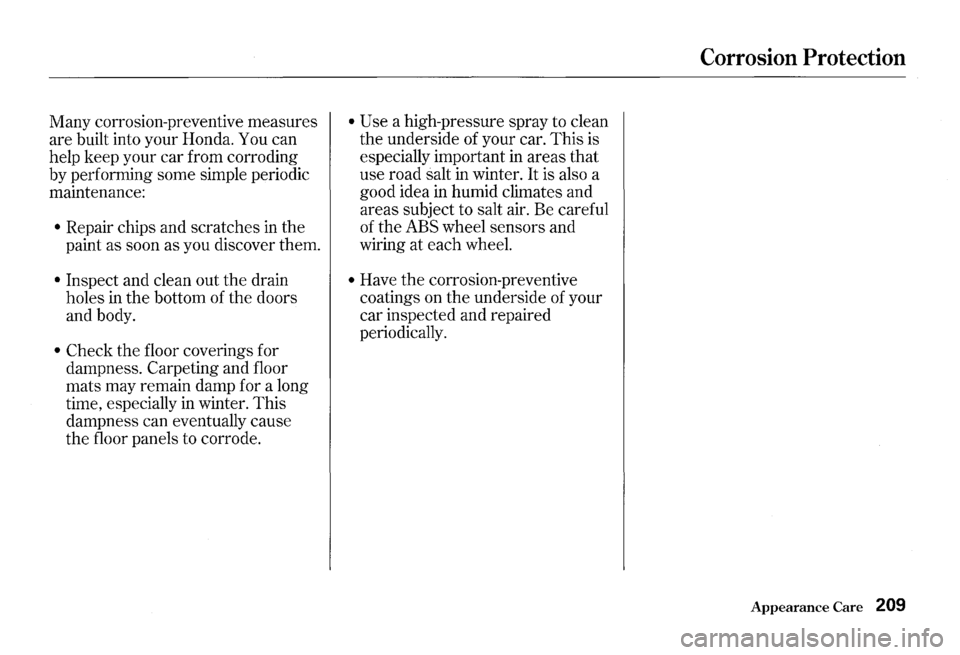
Many corrosion-preventive measures
are built into your Honda.
You can
help keep your car from corroding
by performing some simple periodic
maintenance:
• Repair chips and scratches in the
paint as soon as you discover them.
• Inspect and clean out the drain
holes
in the bottom of the doors
and body.
• Check the floor coverings for
dampness. Carpeting and floor
mats may remain damp for a long
time, especially
in winter. This
dampness can eventually cause
the floor panels to corrode.
• Use a high-pressure spray to clean
the underside of your car. This is
especially important
in areas that
use road salt
in winter. It is also a
good idea
in humid climates and
areas subject to salt air. Be careful
of the
ABS wheel sensors and
wiring
at each wheel.
• Have the corrosion-preventive
coatings on the underside of your
car inspected and repaired
periodically.
Corrosion Protection
Appearance Care 209
Page 213 of 273
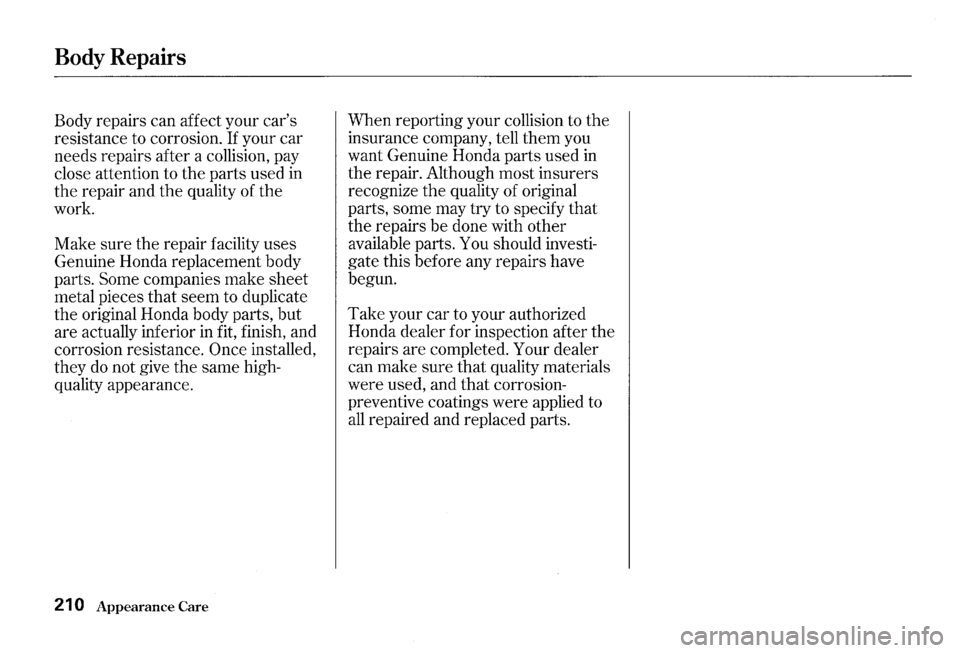
Body Repairs
Body repairs can affect your car's
resistance to corrosion.
If your car
needs repairs after a collision, pay
close attention to the parts used
in
the repair and the quality of the
work.
Make sure the repair facility uses
Genuine Honda replacement body
parts.
Some companies make sheet
metal pieces that seem to duplicate
the original Honda body parts, but
are actually inferior
in fit, finish, and
corrosion resistance.
Once installed,
they
do not give the same high
quality appearance.
21 0 Appearance Care
When reporting your collision to the
insurance company, tell them you
want Genuine Honda parts used
in
the repair. Although most insurers
recognize the quality of original
parts, some may try to specify that
the repairs be done with other
available parts. You should investi
gate this before any repairs have
begun.
Take your car to your authorized
Honda dealer for inspection after the
repairs are completed. Your dealer
can make sure that quality materials
were used, and that corrosion
preventive coatings were applied to
all repaired and replaced parts.
Page 214 of 273
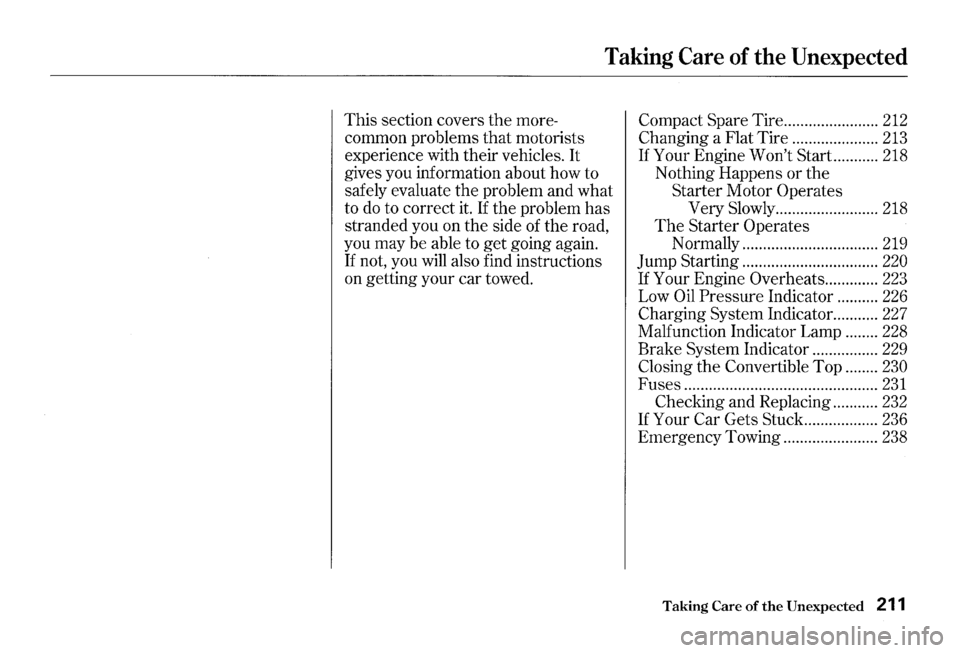
Taking Care of the Unexpected
This section covers the more
common problems
that motorists
experience with their vehicles.
It
gives you information about how to
safely evaluate the problem and what
to
do to correct it. If the problem has
stranded you on the side of the road,
you may be able to get going again.
If not, you will also find instructions
on getting your car towed. Compact
Spare Tire .......................
212
Changing a Flat Tire ..................... 213
If Your Engine Won't Start ........... 218
Nothing Happens or the
Starter Motor
Operates
Very
Slowly ......................... 218
The Starter Operates
Normally ................................. 219
Jump Starting ................................. 220
If Your Engine Overheats ............. 223
Low Oil Pressure Indicator .......... 226
Charging System Indicator.. .........
227
Malfunction Indicator Lamp ........ 228
Brake System Indicator ................ 229
Closing the Convertible Top ........ 230
Fuses ............................................... 231
Checking and Replacing ........... 232
If Your Car Gets Stuck. ................. 236
Emergency Towing ....................... 238
Taking Care of the Unexpected 211
Page 215 of 273
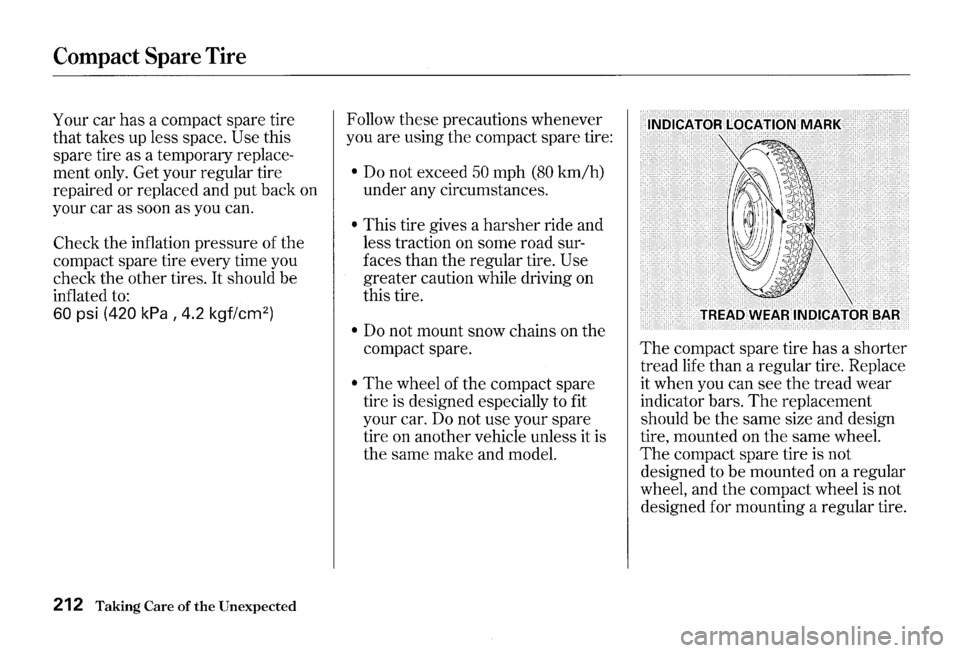
Compact Spare Tire
Your car has a compact spare tire
that takes up less space.
Use this
spare tire as a temporary replace
ment only. Get your regular tire
repaired or replaced and put back on
your car as soon as you can.
Check the inflation pressure of the
compact spare tire every time you
check the other tires.
It should be
inflated
to:
60 psi (420 kPa , 4.2 kgf/cm2
)
212 Taking Care of the Unexpected
Follow these precautions whenever
you are using the compact spare tire:
• Do not exceed 50 mph (80 km/h)
under any circumstances.
• This tire gives a harsher ride and
less traction on some road sur
faces than the regular tire.
Use
greater caution while driving on
this tire.
• Do not mount snow chains on the
compact spare.
• The wheel of the compact spare
tire is designed especially to fit
your car.
Do not use your spare
tire on another vehicle unless it is
the same make and model.
The compact spare tire has a shorter
tread life than a regular tire. Replace
it when you can see
the tread wear
indicator bars.
The replacement
should be the same size and design
tire, mounted on
the same wheel.
The compact spare tire is not
designed to be mounted on a regular
wheel, and
the compact wheel is not
designed for mounting a regular tire.
Page 216 of 273
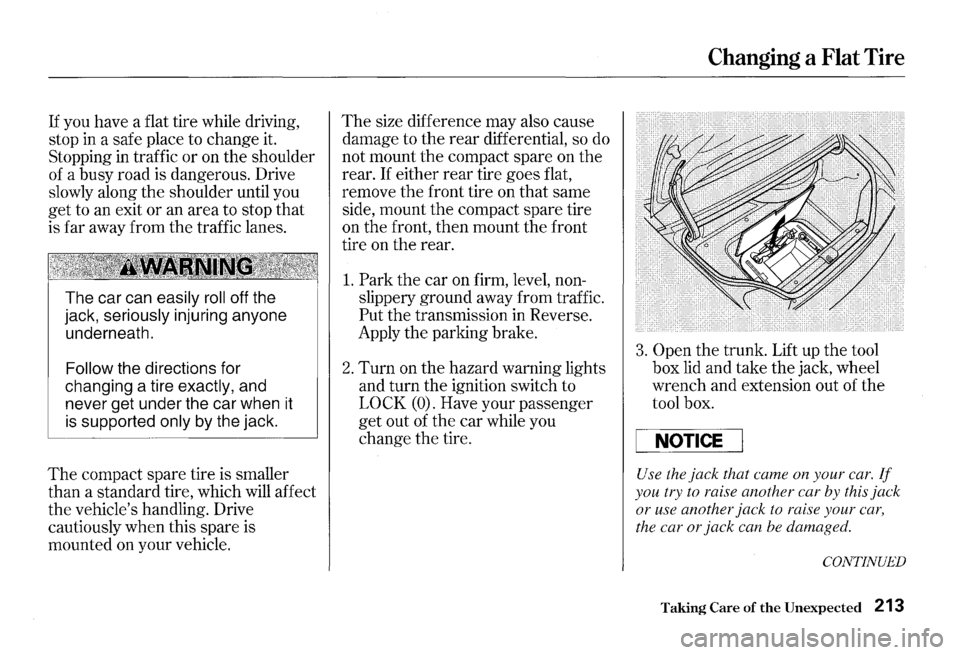
If you have a flat tire while driving,
stop in a safe place to change it.
Stopping in traffic
or on the shoulder
of a busy road is dangerous. Drive
slowly along
the shoulder until you
get to an exit or an area to stop that
is far away from the traffic lanes.
The car can easily roll off the
jack,
seriously injuring anyone
underneath.
Follow the directions for
changing a tire
exactly, and
never get under the car when it
is supported only by the jack.
The compact spare tire is smaller
than a standard tire, which
will affect
the vehicle's handling. Drive
cautiously when this spare is
mounted on your vehicle.
The size difference may also cause
damage to
the rear differential, so do
not mount
the compact spare on the
rear. If either rear tire goes flat,
remove
the front tire on that same
side, mount
the compact spare tire
on
the front, then mount the front
tire on
the rear.
1. Park the car on firm, level, non
slippery ground away from traffic.
Put the transmission in Reverse.
Apply
the parking brake.
2. Turn on the hazard warning lights
and turn
the ignition switch to
LOCK (O). Have your passenger
get out of the car while you
change
the tire.
Changing a Flat Tire
3. Open the trunk. Lift up the tool
box lid and take
the jack, wheel
wrench and extension out of
the
tool box.
NOTICE
Use the jack that came on your car. If
you try to raise another car by this jack
or use another jack to raise your car,
the car
or jack can be damaged.
CONTINUED
Taking Care of the Unexpected 213
Page 217 of 273
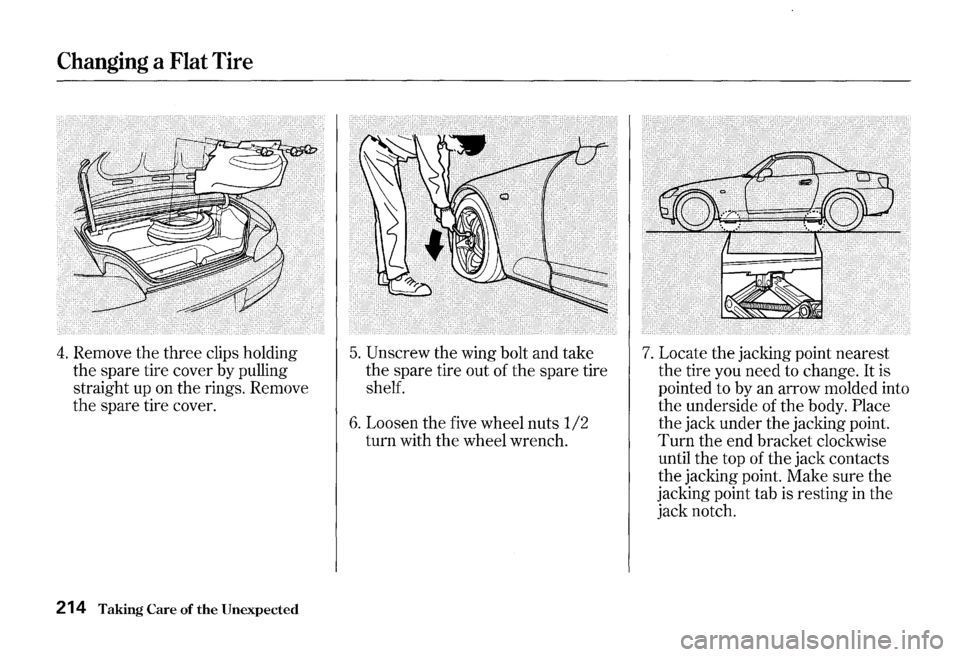
Changing a Flat Tire
4. Remove the three clips holding
the spare tire cover by pulling
straight up on the rings. Remove
the spare tire cover.
214 Taking Care of the Unexpected
5. Unscrew the wing bolt and take
the spare tire out of the spare tire
shelf.
6. Loosen the five wheel nuts 1/2
turn with the wheel wrench.
7. Locate the jacking point nearest
the tire you need to change.
It is
pointed to by an arrow molded into
the underside of the body. Place
the jack under the jacking point.
Turn the end bracket clockwise
until the top of the jack contacts
the jacking point. Make sure the
jacking point tab is resting
in the
jack notch.
Page 218 of 273
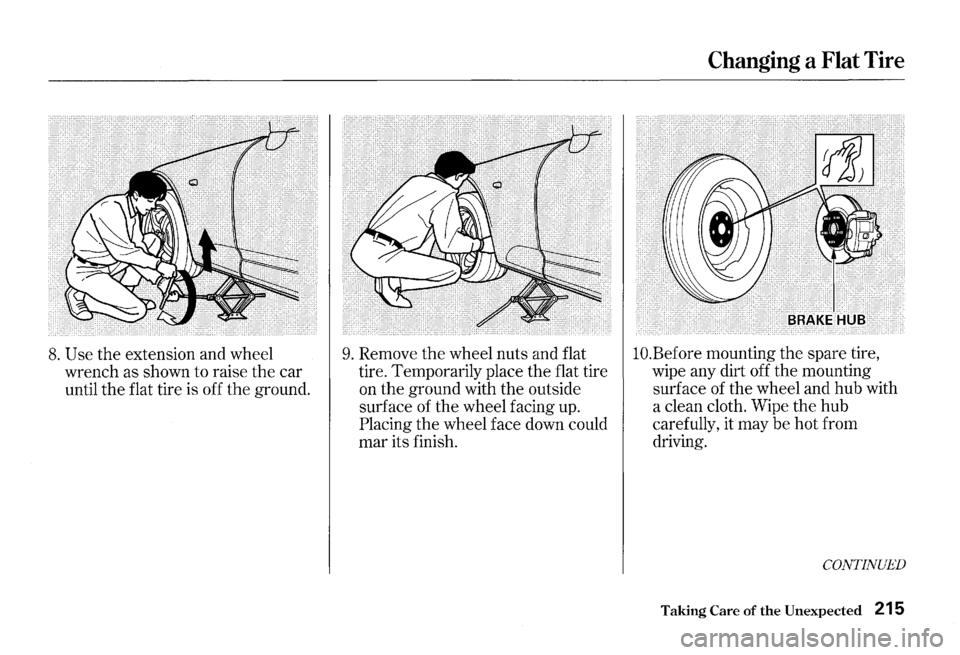
8. Use the extension and wheel
wrench as shown to raise the car
until the flat tire is off
the ground.
9. Remove the wheel nuts and flat
tire. Temporarily place the flat tire
on the ground with the outside
surface of the wheel facing
up.
Placing the wheel face down could
mar its finish.
Changing a Flat Tire
lO.Before mounting the spare tire,
wipe any dirt off the mounting
surface of the wheel and hub with
a clean cloth. Wipe the hub
carefully, it may be hot from
driving.
CONTINUED
Taking Care of the Unexpected 215
Page 219 of 273
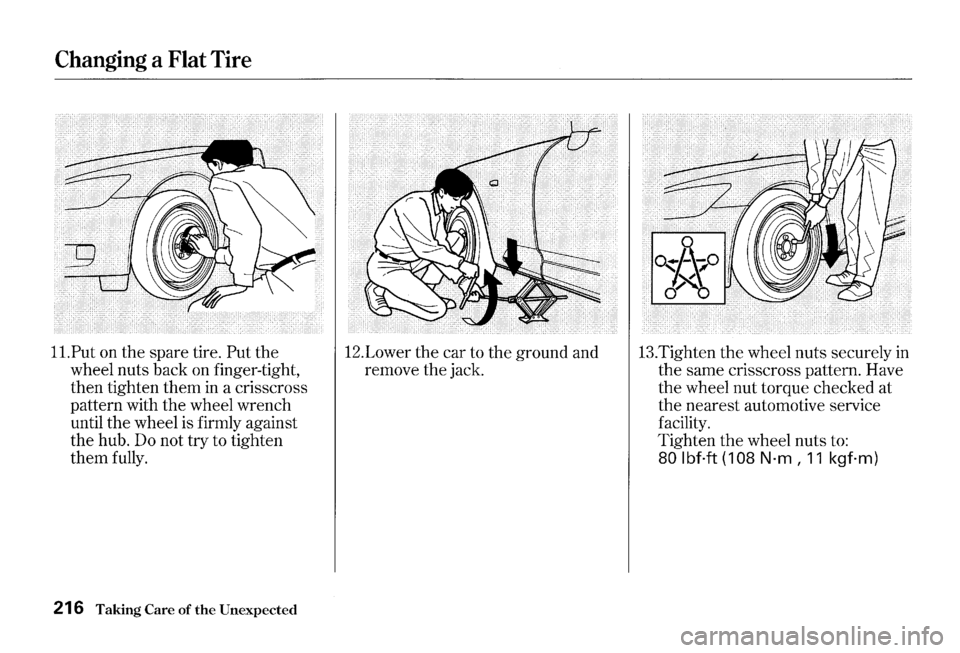
Changing a Flat Tire
ll.Put on the spare tire. Put the
wheel nuts back on finger-tight,
then tighten them
in a crisscross
pattern with the wheel wrench
until the wheel is firmly against
the hub.
Do not try to tighten
them
fully.
216 Taking Care of the Unexpected
12.Lower the car to the ground and
remove the jack. 13.Tighten
the wheel nuts securely in
the same crisscross pattern. Have
the wheel nut torque checked at
the nearest automotive service
facility.
Tighten
the wheel nuts to:
80 lbf.ft (1 08 N·m, 11 kgf·m)
Page 220 of 273
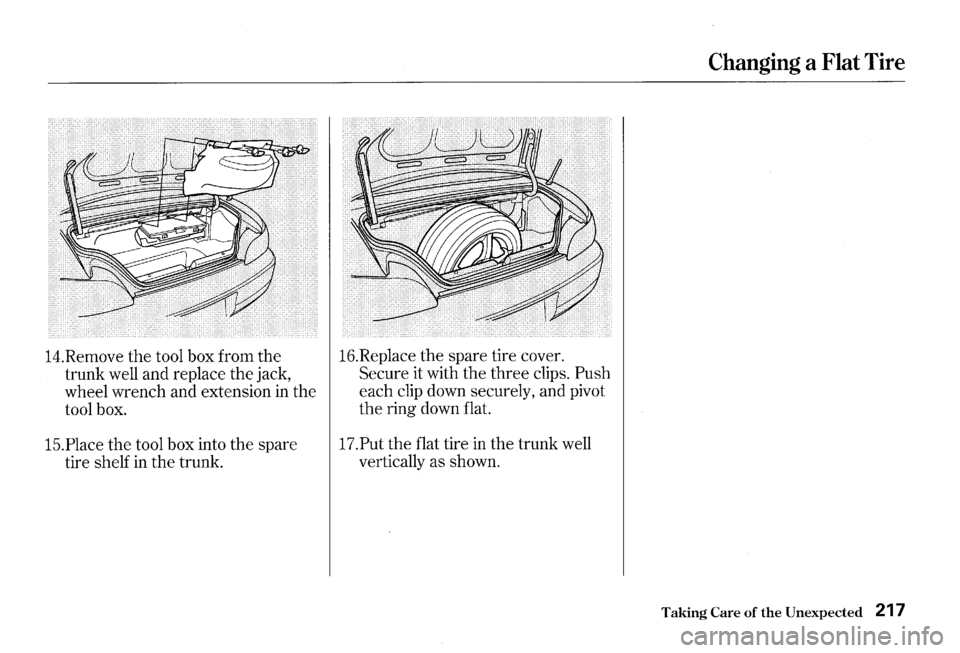
14.Remove the tool box from the
trunk well and replace the jack,
wheel wrench and extension
in the
tool box.
15.Place the tool box into the spare
tire shelf
in the trunk. 16.Replace
the spare tire cover.
Secure it with the three clips.
Push
each clip down securely, and pivot
the ring down flat.
17.Put the flat tire in the trunk well
vertically as shown.
Changing a Flat Tire
Taking Care of the Unexpected 217